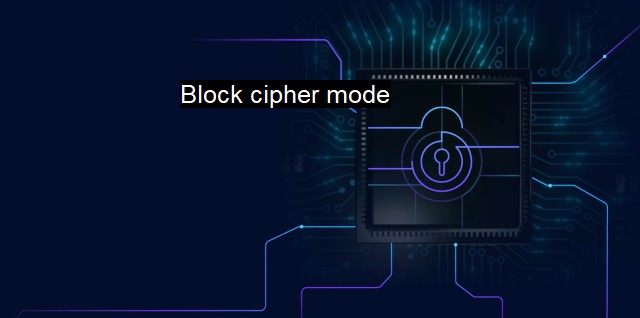What is Block cipher mode?
Understanding Block Cipher Modes for Strong Encryption: The Fundamentals of Cipher Modes and Proper Usage
A block cipher mode is a method that is used in conjunction with cryptographic algorithms to transform plaintext into ciphertext and vice versa. It serves fundamental roles in various cybersecurity and antivirus applications, aiding in the creation of secure digital environments. Modern operational frameworks like electronic payment systems, e-banking, secure network communications, digital signatures, data confidentiality, data authenticity rely on block cipher modes to protect sensitive information from unauthorized access.At the core of its operational principle, a block cipher mode processes plaintext in distinctive blocks. Each block constitutes a fixed number of bits - traditionally 64 or 128, that are converted into ciphertext through the application of a cipher algorithm and a secret key by a sender. Then, a receiver decrypts the ciphertext into plaintext using the same cipher protocol and the secret key. The ability of this transformative process to maintain data security pivots on some attributes intrinsic to block cipher modes.
The first attribute lies in the role of a secret key. A secret key is a pre-agreed set of unique numbers that acts like a digital seal. Its input into the encryption and decryption processes renders a block cipher secure. Without knowledge of the key, deciphering the ciphertext back into plaintext is nearly impossible, providing a robust form of protection against attempts at unauthorized access.
Secondly, block ciphers boost cybersecurity and shield against potential system, network, or software vulnerability through what is known as "confusion and diffusion." Confusion strives to mask the relationship between the secret key and the ciphertext, making it extremely difficult to link the two. On the other hand, diffusion rearranges or disperses plaintext in ensuring any minor change in plaintext or the key produces significant alterations in the ciphertext.
There are five commonly used block cipher modes: Electronic Codebook (ECB), Cipher Block Chaining (CBC), Cipher Feedback (CFB), Output Feedback (OFB), and Counter (CTR). Each of these modes applies the cipher algorithm in distinct patterns, presenting unique combinations of security features.
The Electronic Codebook Mode (ECB) is the simplest among them. It involves independently encrypting each plaintext block. A significant advantage of the ECB model is the parallelism it permits since encryption or decryption can be done simultaneously on all blocks. it has a major downside because identical plaintext blocks yield identical ciphertext blocks, making it less secure.
Then there is the Cipher Block Chaining (CBC) mode, operating on the concept that each plaintext block must be combined with the immediate previous ciphertext block before encryption. This approach ensures that even where two plaintext blocks are identical, their emerging ciphertext blocks differ, thereby enhancing message security.
Cipher Feedback (CFB), Output Feedback (OFB), and Counter (CTR) modes also offer variations on these patterns, with special unique features like byte-level encryption, stream cipher, and better performance in particular computer architectures adding to their appeal.
Block cipher modes are instrumental in the cybersecurity landscape, strengthening systems against cyber threats. Leveraging distinct block manipulation techniques, sequences, and key introductions, they frustrate efforts at covert data interception and breaches. Evaluation between these modes rests on many factors including considerations of computation simplicity, resilience against unauthorized deciphering, inherent cyber vulnerabilities, need for precomputation, and sensitivity to transmission error. As such, no mode reigns supreme and each has its situational applications within the diverse realm of cybersecurity and antivirus operations.

Block cipher mode FAQs
What is block cipher mode in cybersecurity?
Block cipher mode is a method of encrypting data in a way that ensures the confidentiality and integrity of the information. It is used in conjunction with block ciphers to protect data from unauthorized access and manipulation.What are the different types of block cipher modes?
There are several types of block cipher modes, including Electronic Codebook (ECB), Cipher Block Chaining (CBC), Cipher Feedback (CFB), and Output Feedback (OFB). Each mode has its own unique characteristics and is suited for different types of data encryption.Why is block cipher mode important in antivirus software?
Block cipher mode is important in antivirus software because it provides an additional layer of protection against malware and other cyber threats. By encrypting data using block cipher mode, antivirus software can prevent hackers and attackers from intercepting and accessing sensitive information, thereby safeguarding the user's privacy and security.How does block cipher mode differ from stream cipher mode?
Block cipher mode differs from stream cipher mode in how it encrypts data. Block cipher mode encrypts data in fixed-size blocks, while stream cipher mode encrypts data one bit or byte at a time. Block cipher mode is typically slower but more secure, while stream cipher mode is faster but less secure.| | A | | | B | | | C | | | D | | | E | | | F | | | G | | | H | | | I | | | J | | | K | | | L | | | M | |
| | N | | | O | | | P | | | Q | | | R | | | S | | | T | | | U | | | V | | | W | | | X | | | Y | | | Z | |
| | 1 | | | 2 | | | 3 | | | 4 | | | 7 | | | 8 | | |||||||